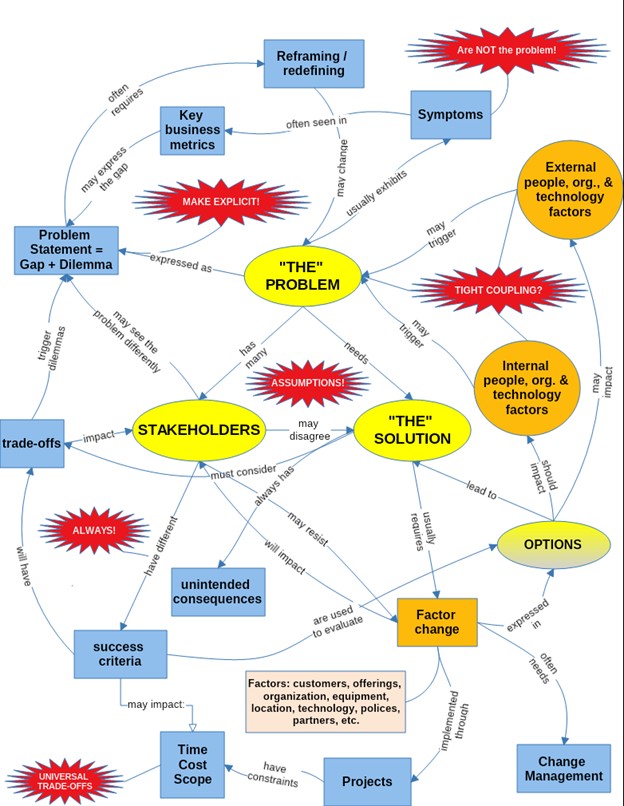A Problem-Solving Quiz (with answers)
A bunch of years ago a large organization asked me to develop a self-study course focused on problem solving. I recently found a quiz that I developed and thought you might be interested in it. The answers follow, but don’t cheat.
Quiz
- Explain the difference between “thinking like Thomas Edison” and “thinking like Benjamin Franklin” as problem-solving strategies. Provide a brief example of when each might be most useful.
- Describe the 80/20 rule (Pareto principle) and how it can be applied to problem-solving in a workplace health and safety context.
- What are four key context questions that should be addressed when facing a problem.
- Explain the anchoring bias and provide a workplace example of how it might negatively impact decision-making during problem-solving.
- Describe the purpose of the Kepner-Tregoe Decision Matrix and briefly outline two of its key steps.
- What is Ockham’s Razor, and how can it be used as a heuristic in problem-solving?
- Explain the Plan-Do-Check-Adjust (PDCA) cycle and its application in continuous improvement.
- Differentiate between external and internal obstacles to problem-solving, providing one example of each.
- Explain the concept of “framing bias” and why it’s important to consider multiple perspectives when defining a problem.
- Describe the purpose of a cause-and-effect diagram (like a fishbone diagram) in root cause analysis.
Quiz Answer Key
- “Thinking like Thomas Edison” involves using trial and error, experimenting with different solutions until one works. This is useful for complex problems with many unknowns. “Thinking like Benjamin Franklin” involves creating a list of pros and cons to weigh the potential benefits and drawbacks of a course of action, helpful for making decisions with competing factors.
- The 80/20 rule suggests that roughly 80% of effects come from 20% of causes. In workplace health and safety, this means identifying the 20% of hazards that are likely to cause 80% of injuries and prioritizing their elimination.
- Four key context questions are: What’s going on here? (Understanding the problem), Why did this happen? (Identifying the cause), What should we do about it? (Developing solutions), and What are the consequences of resolving the problem? (Evaluating the impact).
- The anchoring bias is the tendency to over-rely on the first piece of information encountered (the “anchor”) when making decisions. For example, if a manager initially suggests a two-week deadline for a project, the team might unconsciously base their planning around this timeframe, even if it’s unrealistic.
- The Kepner-Tregoe Decision Matrix is a tool for analyzing alternative solutions based on weighted requirements. Two key steps include: identifying and ranking the requirements with assigned weights, and scoring each alternative based on how well it satisfies each requirement.
- Ockham’s Razor is a principle stating that, when presented with competing hypotheses that explain the data equally well, the one with the fewest assumptions should be selected. In problem-solving, this suggests choosing the simplest solution that effectively addresses the problem.
- The PDCA cycle is an iterative four-step management method used for the control and continuous improvement of processes and products. It involves: Plan (identifying objectives), Do (implementing the plan), Check (studying the results), and Adjust (taking corrective action).
- External obstacles are factors outside of an individual’s control, such as insufficient time or budget. Internal obstacles are built-in cognitive biases, such as the confirmation bias (seeking information that confirms existing beliefs).
- Framing bias occurs when the way a problem is presented (or “framed”) influences how it is perceived and what solutions are considered. Considering multiple perspectives is crucial to avoid solving the wrong problem based on a limited viewpoint.
- A cause-and-effect diagram helps to visually organize potential causes of a problem (the effect). By brainstorming and categorizing various factors, it aids in identifying the root causes rather than just the symptoms of a problem.
Having the skills of a prepared mind is essential to solving complex problems.
If you’d like to get a list of these thinking skills, their barriers, and some proven thinking tools, you can grab it HERE. That will also put you on the list for the weekly edition of MindPrep Resources, our small contribution to engaged critical and strategic thinking. Please note that you can unsubscribe at any time, and we NEVER share email information.
Never miss out!
Get an email update every time I publish new content. Be the first to know!

